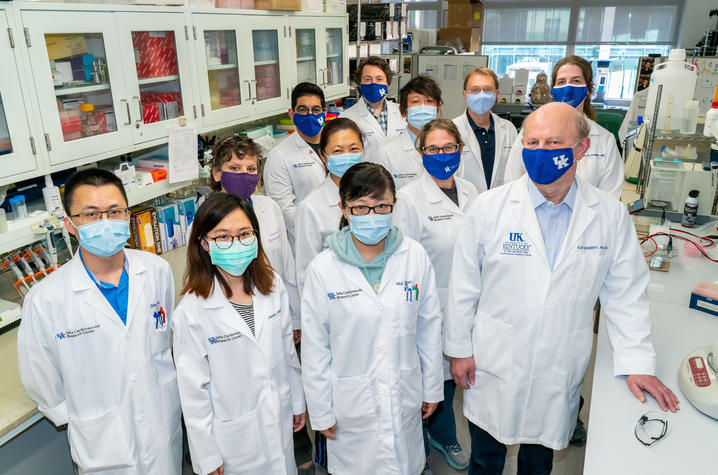UK Research Could Lead to Treatment for Aortic Aneurysms
LEXINGTON, Ky. (June 1, 2021) — Thanks to a $5.6 million grant from the National Institutes of Health (NIH), a University of Kentucky College of Medicine team will study the culprit behind thoracic aortic aneurysms, which could lead to a treatment for the potentially deadly disease.
A thoracic aortic aneurysm is a weakened area in the aorta, the main artery that carries blood away from the heart to the body. The condition puts people at risk for a dissection, the rupturing of the aorta that can cause life-threatening bleeding or sudden death.
Understanding why the aorta’s tissue lends itself to thoracic aortic aneurysms and dissection (TAAD) could translate into treatments for the disease, says Alan Daugherty, Ph.D., chair of the UK Department of Physiology and director of the Saha Cardiovascular Research Center and the Saha Aortic Center in the UK College of Medicine.
There are currently no medications to directly treat the condition or prevent an aneurysm from growing. Patients typically take a “watchful waiting” approach, where the aneurysm is scanned regularly to see if it grows enough to require surgical repair.
Daugherty received a seven-year $5.6 million R35 grant from the NIH’s National Heart, Lung, and Blood Institute (NHLBI) to study the tissues of the aorta and provide insight into how and why TAAD occurs.
“We hope this research program will contribute to providing new medical options so that watching and waiting won't be the only option for these patients,” Daugherty said. “This grant gives us an opportunity to find pathways for a drug therapy to stop the aneurysm from growing so patients can avoid surgical intervention.”
While thoracic aortic aneurysms can happen spontaneously and without a known cause, they are also associated with a wide range of both genetic and non-genetic diseases or syndromes. In these cases, aneurysms tend to occur in very specific parts of the aorta.
For example, Daugherty says that men in their 60s who have smoked tend to have an aneurysm in the lower portion of the aorta. For people with Marfan syndrome, an inherited disorder that affects connective tissue, aneurysms commonly occur in the section of the aorta that connects to the heart. His research program seeks to understand what causes the differences, and the findings could provide a target for drug development.
“The tissue throughout the aorta is apparently similar. If you looked at different samples under a microscope, you probably wouldn’t see any obvious differences. But because the locations of aneurysms associated with diseases are so specific, that may not be the case,” Daugherty said. “So what is it about this tissue that makes it quite different depending on where it is? And why is it that certain diseases affect certain parts of the aorta and leave the rest totally untouched?”
The key may be in a material called extracellular matrix, which binds aortic tissue together. The extracellular matrix is what degrades to weaken the tissue in an aneurysm, and researchers currently have little understanding about what makes that happen.
Using state-of-the-art tools including ultrasonography, MRI and micro-computed tomography, Daugherty’s lab will seek to define how the extracellular matrix fibers are laid down and what makes them either stable or unstable. Their findings in mouse models will be validated in human TAAD samples from a tissue bank at the Baylor College of Medicine.
As the NHLBI R35 grant is intended to give scientists more freedom to conduct groundbreaking research, it will also give Daugherty’s lab the flexibility to pursue potential contributions of other tissues and organs to TAAD, as well as TAAD’s effects on them.
The program will also build upon his lab’s ongoing research to expand the understanding of how the aorta develops. His team has already identified unique mechanisms in the way that the aorta grows that could provide more insight for potential drug development.
Two other researchers in the Saha Cardiovascular Research Center – Xiangan Li and Sidney Whiteheart – recently received NIH R35 grants. Daugherty says it’s significant that UK has this number of the prestigious awards within the area of cardiovascular research.
“The R35 is unique in that it really focuses on the individual and their research track record rather than the specifics of a project,” Daugherty said. “These awards recognize a chronic level of achievement and are a testament to the strength of cardiovascular research across this campus.”
